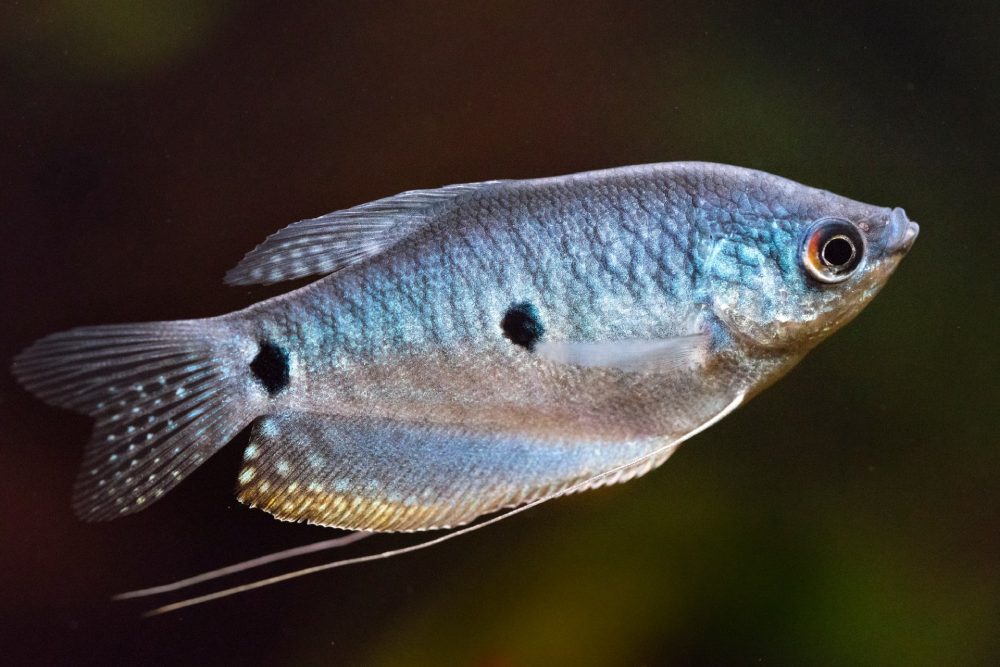Physical Characteristics
Opaline Gourami is popular for its beautiful blue or blue-green coloration, adorned with a marbled or mottled pattern that varies among individuals. They typically have a slender, oval-shaped body with two distinctive spots: one at the center of the body and another at the base of the tail fin. However, the Opaline variety lacks these spots, displaying a more uniform color with intricate patterning. Mature Opaline Gouramis can reach a size of about 4 to 6 inches (10 to 15 cm), with males generally being larger and more vibrantly colored than females. Males also exhibit longer and more pointed dorsal fins compared to the rounded fins of females, a characteristic that becomes more pronounced as they age.
Habitat and Tank Requirements
In their natural habitat, Opaline Gouramis thrive in slow-moving or stagnant waters such as swamps, rice paddies, and lowland rivers. They are highly adaptable and can survive in various water conditions, but they prefer a warm, slightly acidic to neutral pH environment. For aquarists, replicating their natural habitat is essential for their well-being. A minimum tank size of 30 gallons is the best for a pair of Opaline Gouramis. Larger tanks are preferable, especially if you plan to keep them with other fish, to provide ample swimming space and reduce territorial aggression.
They thrive in water temperatures between 75-82°F (24-28°C), with a pH range of 6.0-8.0 and hardness between 5-20 dGH. While they can tolerate low-oxygen environments, a good filtration system helps maintain water quality. Gentle water flow is ideal to mimic their natural habitat. Dense vegetation, driftwood, and rocks provide hiding spots and create a sense of security. Floating plants are particularly beneficial as they offer shade and reduce light intensity, which can stress the fish.

Behavior and Tank Mates
Opaline Gouramis are generally peaceful but can exhibit territorial behavior, especially males. It’s important to monitor their interactions and provide enough space and hiding spots to mitigate aggression. They are labyrinth fish, meaning they can breathe atmospheric air thanks to a specialized organ called the labyrinth organ. This adaptation allows them to survive in oxygen-poor waters. When choosing tank mates for Opaline Gouramis, consider species that are similar in size and temperament. Suitable companions include other Gourami species (with caution to prevent territorial disputes), peaceful barbs and tetras, Corydoras catfish, Rainbowfish, and livebearers like Mollies, Platies, and Swordtails. Avoid fin-nipping species like Tiger Barbs or overly aggressive fish that may stress or harm the Gouramis.
Diet and Feeding
Opaline Gouramis are omnivores with a hearty appetite. In the wild, they feed on a variety of insects, crustaceans, and plant matter. In an aquarium setting, they should be offered a balanced diet that includes high-quality flake or pellet food, frozen or live foods such as bloodworms, brine shrimp, and daphnia, and vegetable matter like blanched spinach or zucchini. Feeding should be done once or twice daily, with only as much food as they can consume in a few minutes to prevent overfeeding and water quality issues.
Breeding Opaline Gouramis
Breeding Opaline Gouramis in captivity is relatively straightforward with the right conditions. A separate breeding tank with a gentle filter and plenty of plants or breeding mops is ideal. The water temperature should slightly increase up to around 80°F (27°C). Feeding the breeding pair high-quality live or frozen foods conditions them for spawning. The male will build a bubble nest at the water surface using saliva bubbles and plant matter. Once the nest is ready, he will court the female, leading to a spawning embrace where the female releases eggs and the male fertilizes them.
After spawning, it’s advisable to remove the female to prevent aggression from the male, who will guard the nest. Once the fry hatch, usually within 24-48 hours, the male should also prevent him from eating the fry. Feed the fry infusoria or commercially available liquid fry food initially, transitioning to baby brine shrimp and finely crushed flakes as they grow.
Health and Disease
Opaline Gouramis are hardy fish but can still be susceptible to common freshwater diseases. Maintaining good water quality and a stress-free environment is crucial for their health. Some common ailments include Ich (White Spot Disease), characterized by white spots on the body and fins, which can be treated by raising the water temperature and using appropriate medications. Fin Rot, often caused by poor water conditions, leads to fraying and disintegration of fins; improving water quality and using antibacterial treatments can help. Internal and external parasites can also affect Opaline Gouramis, so it’s important to quarantine new fish and use antiparasitic treatments if necessary.
Conclusion
Opaline Gouramis are a captivating addition to any freshwater aquarium, offering both beauty and an interesting behavior profile. With proper care, they can thrive and even breed in a home aquarium, providing aquarists with an enriching and rewarding experience. Their peaceful nature and adaptability make them suitable for both beginner and experienced fish keepers, contributing to their enduring popularity in the aquarium hobby.









